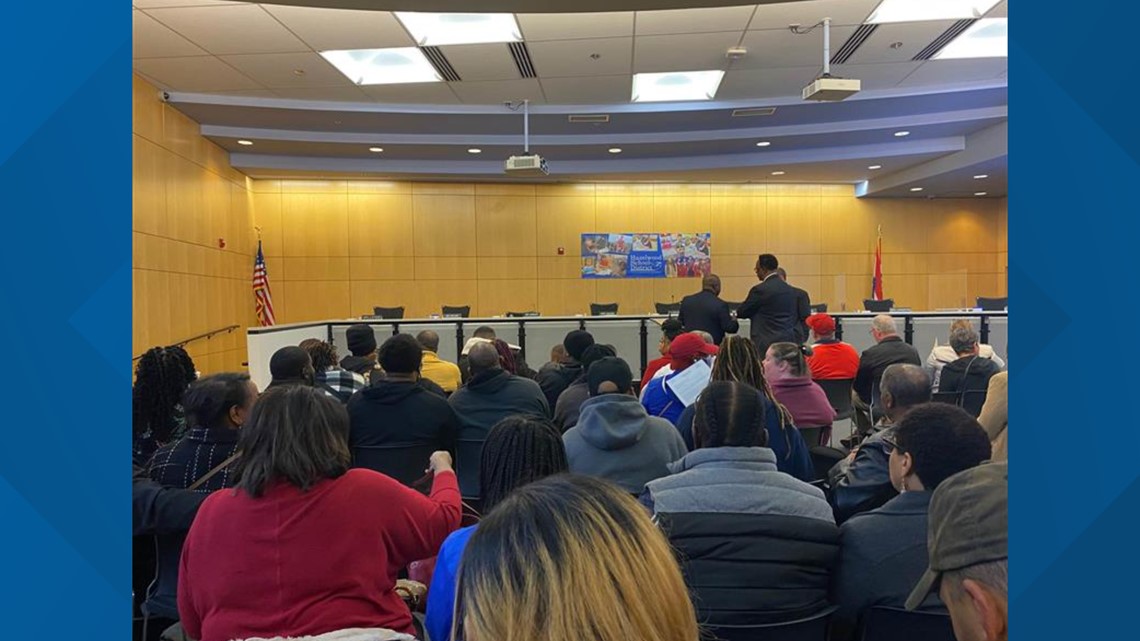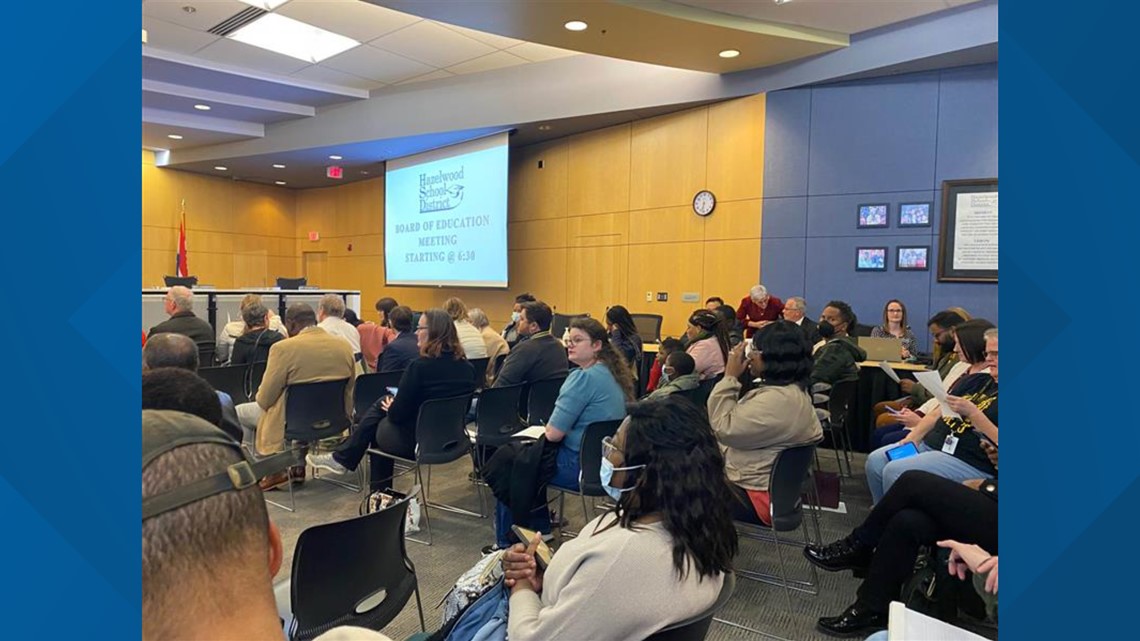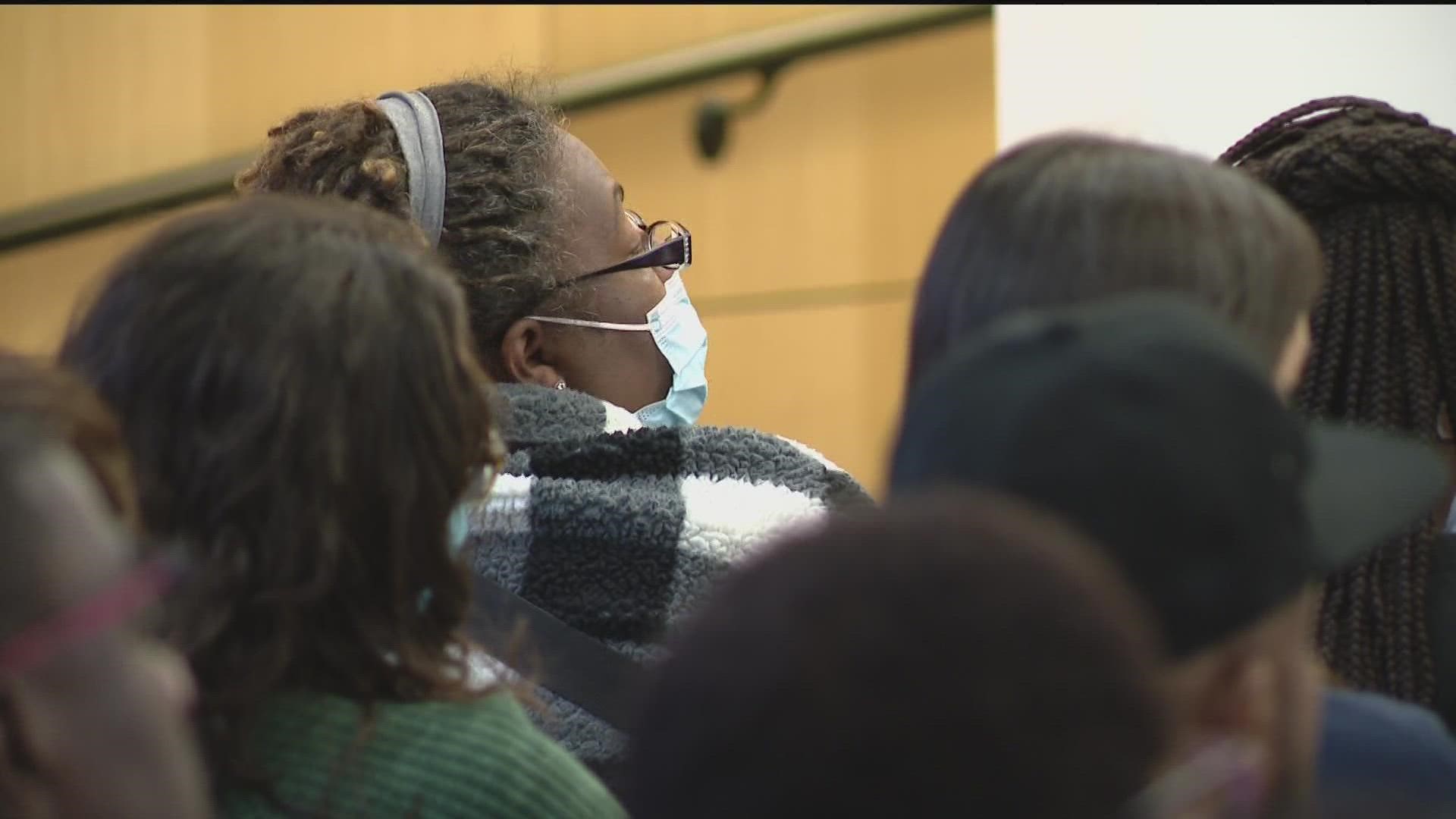FLORISSANT, Mo. — Hazelwood School District parents are demanding answers after high levels of radioactive waste were found at Jana Elementary School in St. Louis County. Tuesday night, they received the district's plan to move forward, along with an apology.
"The administration will move forward with Jana Elementary converting to all virtual instruction," Hazelwood School Board President Betsy Rachel said.
She acknowledged no one in the room knew the community would be dealing with this in 2022.
The radioactive waste has been a problem since the 1940s, when it was first dumped in Coldwater Creek, right by the elementary school.
"This is causing a disruption to our students' education and school climate. For that, we sincerely apologize," Rachel said.
"In August, after bringing you this news, you all decided not to communicate this to our community...I did...our PTA did," PTA President Ashley Bernaugh told the board.
"The very first place I heard about it was on the news. In the news statement, they said we were notified, and they weren't," Patrice Strickland, a parent, said.
Some said now is the time to band forces, working as a team to get past this.
"While we can debate your timing. We can debate your decision process. We are all victims of this waste," a speaker said before the board.
Beginning Monday, students at Jana Elementary will go to remote learning before being placed in new school buildings.
Two preschool classrooms will remain in-person but will attend Barrington Elementary School.
School officials said, beginning the week of Nov. 14, parents will start to be notified of where their students will report to school on Nov. 28.
"I was so relieved with your plan. I'm so happy you all are considering our babies now, but just communicate with us. That's all we want, just communication to know what's going on," Strickland said.
"They could've had the entire pandemic to clean up Jana Elementary. Our community deserves that level of leverage," Bernaugh said.
School officials say they will authorize a study of their own but stressed that immediate cleanup of any hazardous material is a priority.
The history
St. Louis was a big part of the Manhattan Project.
Mallinckrodt Chemical Works, located north of downtown St. Louis, processed a majority of the uranium for the building of the first atomic bomb.
The waste from Mallinckrodt was transported and stored at a site north of St. Louis Lambert International Airport from 1947 until the late-1960s.
It was then purchased by Continental Mining and Milling Company and moved to a site half a mile away.
The radioactive waste was not stored in a protective manner, and this resulted in the washing of radioactive material into nearby Coldwater Creek.
The creek, going upstream and downstream, carried this radioactive material into north St. Louis County, contaminating much of the soil around the creek.
The testing
In June, Ashley Bernaugh, who is Parent Teacher Assocation (PTA) president, pushed the state Board of Education (BOE) to inform the public about this.
The BOE took it up in two separate meetings in June and July.
For the July meeting, the group decided to not act and tell the parents about this radioactive material.
Bernaugh believes the board had been given wrong information by the United States Army Corps of Engineers (USACE) and was given misleading details.
After attaining a Freedom of Information Act or FOIA request and gaining access in 2021, Bernaugh found details of a map with more sample results involving Jana's property.
The PTA sent a letter to the board with this information and the BOE responded with this new letter to parents.
The reaction
5 On Your Side talked to concerned parents ahead of the meeting.
Johnson has lived just less than a mile away from Jana Elementary for almost a decade, until now.
"I'm actually selling my house on Friday," he said.


After the Boston Chemical Data Corporation found high levels of radioactivity inside parts of the school and on the playground, the family is now packing up and moving out.
"I have four daughters under the age of 13 that have all lived in that area, and gone to school there," he said.
Bernaugh said these test results are long overdue.
"We have been denied every opportunity to receive testing closer to the school, inside the school," she said.
Bernaugh said it's time for the USACE to clean up the waste.
"It's unfair to make our kids suffer any way in their education for the mistakes of government agencies that are perfectly capable of funding another place to learn, and cleaning up the mess they left behind," she said.
Johnson, too, wants a safer future for his own daughter.
"I want there to be an option for her to go to the Hazelwood School District in any school that I choose," he said.


The experts
The Boston Chemical Data Corp. study of Jana Elementary said, the test results indicate high levels of radioactive lead, Polonium also known as Pb 210 found in the following areas:
- Inside the Jana Elementary school building (specifically on the cafeteria fan, in the boiler room, and in the school library).
- Jana Elementary school playground areas’ soil (specifically the kindergarten play area and near the basketball court area)."
Program Manager Phil Moser, USACE, and St. Louis District, sent 5 On Your Side a statement regarding the Boston Chemical Data Corp. study:
“The US Army Corps of Engineers, St. Louis District Formerly Utilized Sites Remedial Action Program (FUSRAP) team is committed to our mission of executing the Record of Decision (ROD) for The North St. Louis County Sites. Our team will evaluate the Boston Chemical Data Corp. report and methods used to create these results. The Boston Chemical Data Corp. report is not consistent with our accepted evaluation techniques and must be thoroughly vetted to ensure accuracy.
The Jana Elementary School property does have FUSRAP contamination near the CWC bank that is below ground surface and in a densely wooded area. However, the sample locations in the actual floodplain between the Coldwater Creek (CWC) bank and playground area are not contaminated.
While the evaluation is ongoing, early indications from the data are that the FUSRAP contamination is isolated to the CWC bank. The team has been coordinating with the Hazelwood School District regarding the status of sampling on the property. Any contamination posing a high risk or immediate threat to human health or the environment would be made a priority for remediation.
In addition to this property, our team of local area scientists and engineers have collected more than 40,000 samples and various measurements from along CWC. The St. Louis FUSRAP Team takes pride in the use of industry standard sampling and analysis procedures, consistent evaluations using the Multi-Agency Radiation Survey and Site Investigation Manual (MARSSIM), third party reviews and a robust quality control / quality assurance program. We also consult with state and federal regulatory agencies to ensure our methods and conclusions are consistent and in accordance with the Comprehensive Environmental Response, Compensation, and Liability Act (CERCLA) process.
The St. Louis FUSRAP Team remains committed to this community and will continue to perform our primary mission of protecting human health and the environment.”
A new, independent study also reveals radioactive metals were found in the soil.
The study comes from Dr. Richard Troast, a toxicologist and environmental scientist with decades of experience.
"It is very clear that the level of radiation found at the Jana Elementary School far exceeds the threshold or 5pCi, and the levels of radioactivity identified are likely to result in an unacceptable risk to the children residing in the Coldwater Creek area,” he said.
If there's something newsworthy happening where you live send us an email to newstips@ksdk.com and our team of reporters will look into it.

